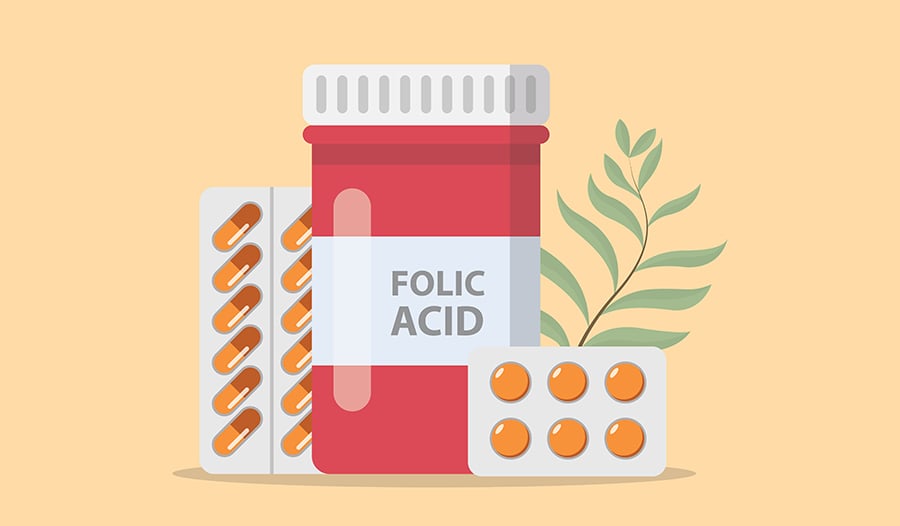Prevence nedostatku kyselin listových kyselin: Posílení zdraví pro zdravé děti

Co je kyselina listová?
Kyselina listová, také známá jako folát nebo vitamin B9, je dobře známý ve vodě rozpustný vitamin.
Již tato písmena — „vitamín rozpustný ve vodě“ nám umožňují vypracovat dva důležité závěry:
- Human body nedokáže syntetizovat kyselinu listovou, and must be from the food (proto je vitamin).
- Rozpustnost listových kyselin ve vodě brání v tom, abychom se vybudovali v těle - takže listová kyselina musí být vždy přítomna v lidské stravě, aby se udrželo zdraví.
Rozdíl mezi folátem a kyselinou listovou
Ačkoli slova „folate“ and „acid list“ are most always for synonyma, existuje malý, ne vždy jasný a ne zásadní rozdíl: „folate“ obvykle znamená přirozený původ látky. Proti tomu, „acid listová“ is a industrial production.
Co dělá kyselina listová v těle?
Kyselina listová asigură cellers division process, are impact on the thesis of food and is a basic factor, which the normal working of the hematopoetic system.
No divu that the listary acid hypovitaminosis (deficit) is connected with all series of health problems in adult and children. The most common use is development of special forms of anemia, in which the size of the red blood - erytrocyts - are and of their function related to transport of the oil and oxygen. V důsledku toho, the four symptom of anemia are - slabost, dušnost, bušení srdce a kožešina.
Food resources listové kyseliny
Folát, v dostatečném množství, aby uspokojil lidské potřeby, je přítomen v mnoha potravinách rostlinného a živočišného původu. Hlavní zdroj potravy folátu je zelená listová zelenina.
Folát je bohatý ve špenátu, chřestu, hlávovém salátu, brokolici a zelí (bílé a květákové) and in luštěninách - arašídy, čočka, cizrna a sójové boby. Syrové arašídy are šampiónem — conțin téměř dvakrát tolik folátu než špenát.
In the following list of the most important plant resources of acid acid listes, the solar seed, red paprika, avocado, apple, banana, obiloviny and fruit. Chléb and browns are also important role in our folate needs.
Mezi živočišné produkty jsou látky obsažené v folatech vedlejší produkty z masa (zejména játra), vejce, ryby a maso. V plnotučné mléce není mnoho folátu, ale příprava jogurtu zvyšuje toto množství dvakrát, a u některých odrůd sýrů je kyselina listovaná 10-12krát více než sama množství mléka.
Proč chybí folát?
Na první pohled, hypovitaminóza kyseliny listové je nepravděpodobná, protože existuje poměrně velký seznam levných a dostupných potravin obsahujících dostatek folátu, aby se zabránilo nedostatku.
Existuje však řada faktorů, které je třeba vzít v úvahu:
- Kyselina listová je snížena teplem, takže vaření potravin může snížit folát o 80-90%.
- Kyselina listová je rozpustná ve vodě. To není překvapení, že při vaření (zejména když se voda vylije na konci vaření), v hotovém výrobku se téměř žádný folát nezůstane.
- Someone physical states of body - and - - the need of the listed acid and food with these needs.
- Lipsa kyseliny listové je typická pro řadu onemocnění. This is possible in the of the disease of and. Hypovitaminosis se často projevuje zhoršenou absorpcí, in special in the of of, as like to the possible of of the acid. The common effect of hypovitaminosis in adult — of alkohol.
- Activity of acid list can reduce with a some Drugs -, diuretics, some methods, of, and cancer.
Význam kyseliny listové v těhotenství
Kyselina listová asigură buněčné dělení procesů a podílí se na syntéze zeleniny. It that the active are the process of cell division in the body, that the higher the need of acid is the list. To je zvláštní důvod pro roli folátu během těhotenství.
Also has this role of very specific nuances: for the success of physical effects is very important that in the phase of the start (intime after which the process of active cell division) in the human health of the body of the human of the acid.
The Fourth study that the deficit of the acid is before the or during the Childhood the of the body.
Suplementation of listary acid in dosis 0,4 mg (400 mcg) denně se proto důrazně doporučuje všem ženám v plodném věku, zejména pak, které plánují těhotné a těhotné ženy.
Za nejvýznamnější období, kdy je obzvláště důležité vyhnout se nedostatku folátu, se považuje za jeden měsíc před začátkem do 12 týdnů těhotenství. Avšak se doporučuje začít užívat listaty kyseliny 3 měsíce před plánovaným odběrem a pokračovat po celou dobu těhotenství a následného kojení.
Dávkování kyseliny listové
Neexistuje jasná, jednotná a všeobecně přijímaná odpověď na otázku: „Kolik kyselin listových kyselin bych měl dostat denně, abych předešel incidentům? „. The most of national and international also very simple number.
Ale než se seznámíme s těmito čísly, musíme objasnit velmi důležitý bod. Det finns en relativ významný rozdíl mezi tím, jak je nutriční folát absorbován, and the how to include preparáty listových kyselin (drogy, kosttilskudd). Absorpce folátu v potravinách je asi 50%, zatímco absorpce kyseliny listové je mnohem vyšší a téměř vždy přesahuje 85%.
K zohlednění tohoto významného rozdílu, vědci navrhli speciální měrnou jednotku - DFE - dietní ekvivalent folátu.
1 mcg folátu v potravinách je 1 DFE, ale 1 mcg kyseliny listové je 1,7 DFE. These proporce are the use for all after computing. Hvis, for eksempel, the need to estimate to 600 mcg dietního folátu (600 DFE) per day, to odpovídá asi 353 mcg listové kyseliny (600:1,7).
Uvědomte si, že příjem kyseliny listované u dětí v prvním roce života je stále předmětem výzkumu a probíhajících debat.
Doporučené denní dietní dávky folátu v závislosti na věku v mcg (1 mcg = 1 DFE) jsou následující
- 1 - 3 roky - 150 mcg
- 4 - 8 let - 200 mcg
- 9 - 13 let - 300 mcg
- Více než 14 let - 400 mcg
- Těhotné ženy - 600 mcg
- Kojící ženy - 500 mcg
Jak zabránit nedostatku kyseliny listové
Preventive Užívání kyseliny listové je zvláště důležité těsně před zahájením léčby. The preview of the time of the first time, also may be and.
No divu that many countries the program of of products -, mouky (pšenice, kukuřice) and milk - on the and milk - and this practice shows results, which number of children born with of the neural system.
Extended and general the race of food the diversity of food with focus on fruit and food — the hypovitaminosis of the acid, and this are used without on gender and age.
Tips for good cooking you will have to use a large number of the diet folic. Specific se recomandă utilizarea parníků a mikrovlnné trouby jako alternativa k běžnému vaření potravin s následnými odstraněnými vodami.
Kyselina listová je častou složkou minima multivitaminů a nezbytnou, povinnou složkou of the food and mineral of women used during and.
It is important to know that the research planning and medical support in the phase of the work planning are the most important element of care with the health of mother and child health.
Plánuje vaši rodičovskou rodinu? Pokud ano, musíte se svým partnerem hodně diskutovat: životní styl, očkování, zdraví zubů, domácí zvířata, špatné návyky, užívání léků a mnoho dalšího! A to bude v pořádku, moudré a správné, pokud se setkáte se se svým partnerem tři měsíce před plánovaným začátkem a vyberete si listový acid preparat pro profylaktický příjem společně!
Odkazy:
- https://ods.od.nih.gov/factsheets/folate-HealthProfessional/
- https://ods.od.nih.gov/pdf/factsheets/folate-consumer.pdf
- https://www.mayoclinic.org/drugs-supplements-folate/art-20364625
- https://www.govinfo.gov/content/pkg/FR-1996-03-05/pdf/96-5014.pdf
- https://medlineplus.gov/folicacid.html
- https://www.fda.gov/media/139471/download
VYLOUČENÍ ODPOVĚDNOSTI: Tento blog není určen ke stanovení diagnózy...














































































 Obsah
Obsah
















